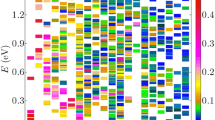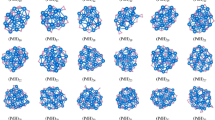Abstract
Structural optimization of Fe nanoclusters is of importance to their applications since their magnetic and catalytic properties are strongly dependent on their structures. In this article, the lowest-energy structures of Fe nanoclusters have been investigated using a multi-populations differential evolution algorithm. Finnis–Sinclair potentials and Johnson potentials have been, respectively, used to describe the interatomic interactions. The algorithm performance has been first evaluated by comparing the results of Finnis–Sinclair potentials with Cambridge Cluster Database. Two lower-energy structures of Fe n clusters (N = 83 and 84) have been discovered. Our results show that many of the structural configurations optimized with the two potentials are different, indicating that the potential model plays an important role in structural optimization. However, the structures of Fe clusters exhibit the similar growth patterns as the cluster increasing for the two potentials, that is, their lowest-energy structures contain many icosahedra, and the number of the icosahedral rings increases with their sizes. Furthermore, the stability analysis by investigating the finite difference and the second finite difference of energy indicates that the two potentials predict the same relative stability at the magic numbers.
Graphical Abstract
The comparison of optimized structures of Fe n clusters at magic numbers (N = 13, 19, 23, 26, 29, 55), respectively, using Finnis–Sinclair and Johnson potentials.








Similar content being viewed by others
References
Bansmann J, Baker SH, Binns C, Blackman JA, Bucher JP, Dávila JD, Dupuis V, Favre L, Kechrakos D, Kleibert A, Meiwes-Broer KH, Pastore GM, Perez A, Toulemonde O, Trohidou KN, Tuaillon J, Xie Y (2005) Magnetic and structural properties of isolated and assembled clusters. Surf Sci Rep 56:189
Bobadova-Parvanova P, Jackson KA, Srinivas S, Horoi M, Ohler CK, Seifert G (2002) Scanning the potential energy surface of iron clusters: a novel search strategy. J Chem Phys 116:3576
Cai WS, Jiang HY, Shao XG (2002) Global optimization of Lennard-Jones clusters by a parallel fast annealing evolutionary algorithm. J Chem Inf Comput Sci 42:1099
Castleman AW, Jena P (2006) Clusters: a bridge across the disciplines of environment, materials science, and biology. Proc Natl Acad Sci U S A 103:10554
Chen Z, Jiang X, Li J, Li S (2013a) A sphere-cut-splice crossover for the evolution of cluster structures. J Chem Phys 138:214303
Chen Z, Jiang X, Li J, Li S, Wang L (2013b) PDECO: parallel differential evolution for clusters optimization. J Comput Chem 34:1046
Clemenger K (1985) Ellipsoidal shell structure in free-electron metal clusters. Phys Rev B 32:1359
Daven D, Tit N, Morris J, Ho K (1996) Structural optimization of Lennard-Jones clusters by a genetic algorithm. Chem Phys Lett 256:195
Deng L, Hu WY, Deng HQ, Xiao SF (2010) Surface segregation and structural features of bimetallic Au–Pt nanoparticles. J Phys Chem C 114:11026
Diéguez O, Alemany MMG, Rey C, Pablo Ordejón, Gallego LJ (2001) Density-functional calculations of the structures, binding energies, and magnetic moments of Fe clusters with 2 to 17 atoms. Phys Rev B 63:205407
Elliott JA, Hamm M, Shibuta Y (2009a) A multiscale approach for modeling the early stage growth of single and multiwall carbon nanotubes produced by a metal-catalyzed synthesis process. J Chem Phys 130:034704
Elliott JA, Shibuta Y, Wales DJ (2009b) Global minima of transition metal clusters described by Finnis–Sinclair potentials: a comparison with semi-empirical molecular orbital theory. Philos Mag 89:3311
Engin C, Sandoval L, Urbassek HM (2008) Characterization of Fe potentials with respect to the stability of the bcc and fcc phase. Model Simul Mater Sci Eng 16:035005
Entel P, Gruner ME, Rollmann G, Hucht A, Sahoo S, Zayak AT, Herper HC, Dannenberg A (2008) First-principles investigations of multimetallic transition metal clusters. Philos Mag 88:2725
Finnis MW, Sinclair JE (1984) A simple empirical N-body potential for transition metals. Phil Mag A 50:45
Goedecker S (2004) Minima hopping: an efficient search method for the global minimum of the potential energy surface of complex molecular systems. J Chem Phys 120:9911
Gollub C, Vivie-Riedle Rd (2009) Modified ant-colony-optimization algorithm as an alternative to genetic algorithms. Phys Rev A 79:21401
Guo JY, Xu CX, Hu AM, Oakes KD, Sheng FY (2012) Sintering dynamics and thermal stability of novel configurations of Ag clusters. J Phys Chem Solids 73:1350
Hartke B (1993) Global geometry optimization of clusters using genetic algorithms. J Phys Chem A 97:9973
Huang WQ, Lai XJ, Xu RC (2011) Structural optimization of silver clusters from Ag141 to Ag310 using a modified dynamic lattice searching method with constructed core. Chem Phys Lett 507:199
Johnson RA (1989) Alloy models with the embedded-atom method. Phys Rev B 39:12554
Johnston RL (2003) Evolving better nanoparticles: genetic algorithms for optimising cluster geometries. Dalton T 22:4193
Köhler C, Seifert G, Frauenheim T (2005) Density functional based calculations for Fe n (n ⩽ 32). Chem Phys 309:23
Lai XJ, Huang WQ, Xu RC (2011) Geometry optimization of atomic clusters using a heuristic method with dynamic lattice searching. J Phys Chem A 115:5021
Li J, Li X, Zhai HJ, Wang LS (2003) Au20: a tetrahedral cluster. Science 299:864
Li YL, Kinloch IA, Windle AH (2004) Direct spinning of carbon nanotube fibers from chemical vapor deposition synthesis. Science 304:276
Lopez N, Janssens TVW, Clausen BS, Xu Y, Mavrikakis M, Bligaardd T, Nørskov JK (2004) On the origin of the catalytic activity of gold nanoparticles for low-temperature CO oxidation. J Catal Philos Mag 223:232
Ma QM, Xie Z, Wang J, Liu Y, Li YC (2007) Structures, binding energies and magnetic moments of small iron clusters: a study based on all-electron DFT. Solid State Commun 142:114
Maruyama S, Kojima R, Miyauchi Y, Chiashi S, Kohno M (2002) Low-temperature synthesis of high-purity single-walled carbon nanotubes from alcohol. Chem Phys Lett 360:229
Meyer R, Entel P (1998) Martensite-austenite transition and phonon dispersion curves of Fe1 − xNix studied by molecular-dynamics simulations. Phys Rev B 57:5140
Moruzzi VL (1986) Singular volume dependence of transition-metal magnetism. Phys Rev Lett 57:2211
Ohta Y, Okamoto Y, Irle S, Morokuma K (2009a) Density-functional tight-binding molecular dynamics simulations of SWCNT growth by surface carbon diffusion on an iron cluster. Carbon 47:1270
Ohta Y, Okamoto Y, Irle S, Morokuma K (2009b) Single-walled carbon nanotube growth from a cap fragment on an iron nanoparticle: density-functional tight-binding molecular dynamics simulations. Phys Rev B 79:195415
Page AJ, Irle S, Morokuma K (2010) Polyyne chain growth and ring collapse drives Ni-catalyzed SWNT growth: a QM/MD investigation. J Phys Chem C 114:8206
Price K, Storn RM, Lampinen JA (2006) Differential evolution: a practical approach to global optimization. Springer, Berlin
Qin LJ, Zhang YH, Huang SP, Tian HP, Wang P (2010) Atomic-scale structure of Co–Pt bimetallic nanoparticles: Monte Carlo simulations. Phys Rev B 82:075413
Rollmann G, Entel P, Sahoo S (2006) Competing structural and magnetic effects in small iron clusters. Comput Mater Sci 35:275
Rondina GG, Da-Silva JLF (2013) Revised basin-hopping Monte Carlo algorithm for structure optimization of clusters and nanoparticles. J Chem Inf Model 53:2282
Schönborn SE, Goedecker S, Roy S, Oganov AR (2009) The performance of minima hopping and evolutionary algorithms for cluster structure prediction. J Chem Phys 130:144108
Takenaka S, Ogihara H, Yamanaka I, Otsuka K (2001) Decomposition of methane over supported-Ni catalysts: effects of the supports on the catalytic lifetime. Appl Catal A 217:101
Wales DJ, Doye JPK (1997) Global optimization by basin-hopping and the lowest energy structures of Lennard-Jones clusters containing up to 110 atoms. J Phys Chem A 101:5111
Wales DJ, Doye JPK (2003) Stationary points and dynamics in high-dimensional systems. J Chem Phys 119:12409
Wang YC, Lv J, Zhu L, Ma YM (2010) Crystal structure prediction via particle-swarm optimization. Phys Rev B 82:094116
Wang Q, Wang H, Wei L, Yang SW, Chen Y (2012a) Reactive sites for chiral selective growth of single-walled carbon nanotubes: a DFT study of Ni55–Cn complexes. J Phys Chem A 116:11709
Wang Y, Miao M, Lv J, Zhu L (2012b) An effective structure prediction method for layered materials based on 2D particle swarm optimization algorithm. J Chem Phys 137:224108
Yuge K (2010) Segregation of Pt28Rh27 bimetallic nanoparticles: a first-principles study. J Phys 22:245401
Yun K, Cho YH, Cha PR, Lee J, Nam HS (2012) Monte Carlo simulations of the structure of Pt-based bimetallic nanoparticles. Acta Mater 60:4908
Zhou XW, Wadley HNG, Johnson RA, Larson DJ, Tabat N, Cerezo A, Kelly TF (2001) Atomic scale structure of sputtered metal multilayers. Acta Mater 49:4005
Acknowledgments
This work is supported by the National Natural Science Foundation of China (Grant Nos. 11474234 and 51271156), the Specialized Research Fund for the Doctoral Program of Higher Education of China (Grant No. 20130121110012), and the Natural Science Foundation of Fujian Province of China (Grant No. 2013J01255).
Author information
Authors and Affiliations
Corresponding author
Rights and permissions
About this article
Cite this article
Liu, TD., Fan, TE., Zheng, JW. et al. Structural optimization of Fe nanoclusters based on multi-populations differential evolution algorithm. J Nanopart Res 18, 77 (2016). https://doi.org/10.1007/s11051-016-3361-x
Received:
Accepted:
Published:
DOI: https://doi.org/10.1007/s11051-016-3361-x




